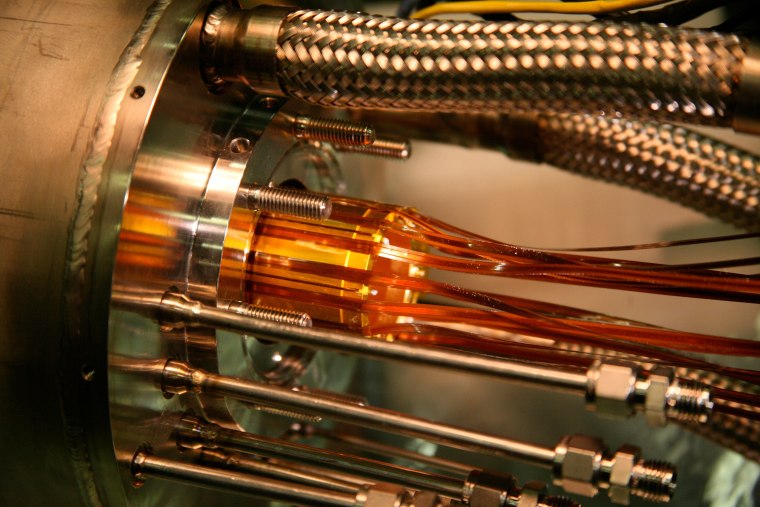After years of effort, scientists have confirmed that they've corralled individual atoms of antimatter.
"We're over the moon," Aarhus University's Jeffrey Hangst, spokesman of the ALPHA collaboration at Europe's CERN particle-physics center, told me today. "I think this was the hardest step in the whole business."
Hangst and his ALPHA colleagues report the breakthrough in Thursday's issue of the journal Nature.
What's so big about making antimatter? On one level, it sounds like the sort of thing mad scientists would do -- for instance, in the Dan Brown thriller "Angels and Demons," which was made into a movie last year. But on a deeper level, studying antimatter sheds light on the fundamental structure of the universe.
In the beginning, equal amounts of matter and antimatter came into existence. At least that's what scientists believe. Today, antimatter is virtually absent in the natural world. Physicists assume that all that antimatter was annihilated when it came into contact with matter -- and that for some as-yet-unknown reason, the matter we know and love had enough of an advantage for a remnant to survive.
Some of the scientists at CERN are using the Large Hadron Collider to sort out that antimatter mystery, but Hangst and others work at a different facility, known as the Antimatter Decelerator. ALPHA is one of the scientific collaborations that has been mixing antiparticles -- positrons and antiprotons -- to try to create whole atoms of antihydrogen.
It's not easy, because of that mutual-annihilation issue. Hangst said the first trick was to combine the particles in a super-cold vacuum setting --- less than 0.5 Kelvin, or -458.8 degrees Fahrenheit. That way, the particles don't instantly jump away and fizzle out. The second trick is to build a magnetic trap to help contain the particles so that they don't instantly decay. And there's a third trick: designing a system capable of verifying that the atoms actually exist.
"You must have a trap, and you must be cold, and you must be able to detect that you've done this," Hangst said.
The ALPHA team's detection system looked for the particles given off when the anti-atoms eventually decayed.
"When antihydrogen decays inside the ALPHA experiment, it emits particles, called pions, from the point at which it exists," the University of Liverpool's Paul Nolan, another member of the ALPHA team, explained in a news release. "Our detector surrounds the area where antihydrogen is formed, and for each pion emitted we get three points as it travels outwards. Using a computer, we can then construct a line between these points and trace it back to the origin of the antihydrogen."
When tens of millions of antiparticles were combined within ALPHA's magnetic trap, the system spotted 38 "annihilation events," verifying the existence of 38 antihydrogen atoms. The atoms lasted for just a tenth of a second, but even that duration would be long enough to allow for further study.
Hangst said the detection marked a "giant leap" toward understanding the properties of antihydrogen, and perhaps eventually sorting out the mystery behind the matter-antimatter imbalance. "Now we have to design the next device, the one that can actually do precision measurements," he said.
Hangst now feels the next giant leap -- measuring the spectrum of antihydrogen and seeing how it compares with regular hydrogen -- is in sight. "I've never been more confident that we can do this," he told me. "It's going to take some years, but the dream of shining laser light on antihydrogen and interrogating its structure is close now."
ALPHA isn't the only scientific collaboration trying to make antihydrogen. Another group, called ATRAP, is using the same facility. "This was a race between us and ATRAP, trying to do the same thing with different techniques," Hangst said.
And in a news release issued today, CERN noted that another collaboration, ASACUSA, has demonstrated yet another method for making antihydrogen atoms. ASACUSA's scientists report in a paper appearing in Physical Review Letters that they produced antihydrogen in a Cusp trap, which CERN says is an "essential precursor" for making a beam.
"With two alternative methods of producing and eventually studying antihydrogen, antimatter will not be able to hide its properties from us much longer," Yasunori Yamazaki, a physicist at Japan's RIKEN research center and a member of the ASACUSA collaboration, said in CERN's news release.
But will the bad guys use all this information to build an antimatter bomb like the one in "Angels and Demons"? That scenario is still pure science fiction, and you can hear theoretical physicist Michio Kaku explain why in our "Nightmares and Dreams" interactive.
More about antimatter:
- Inside the antimatter factory
- Antimatter particles detected deep below
- Antimatter scout to hitch ride on shuttle
- Laser technique produces blast of antimatter
Connect with the Cosmic Log community by "liking" the log's Facebook page or following @b0yle on Twitter. You can also check out "The Case for Pluto," my book about the controversial dwarf planet and the search for new worlds.
